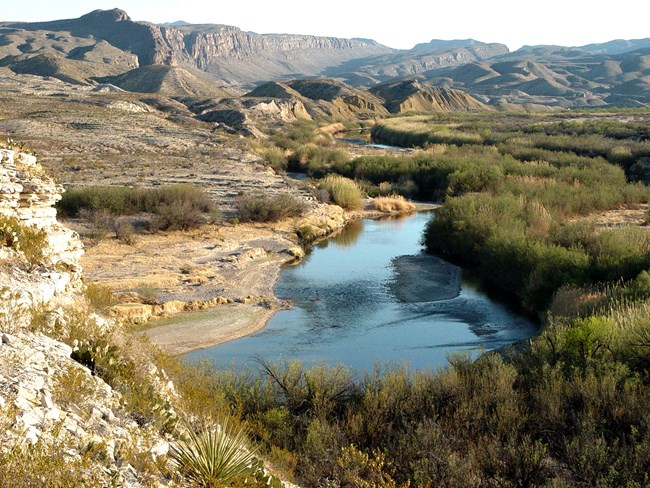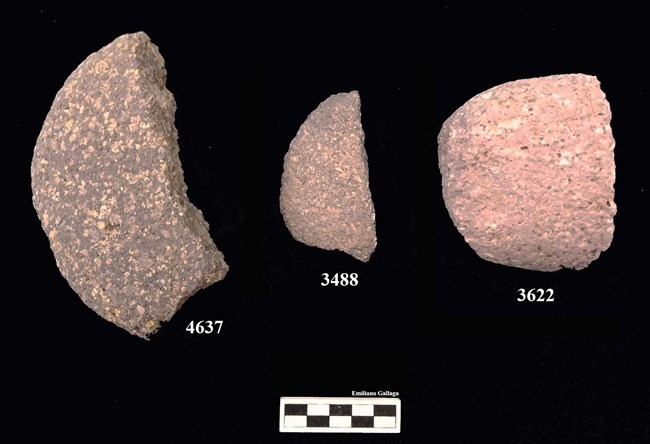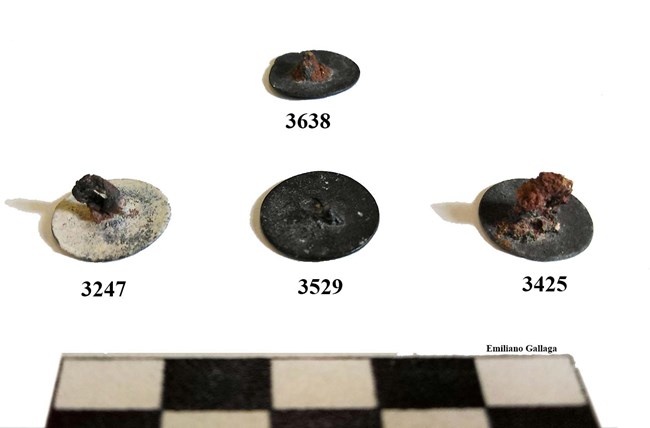Article
Presidios of the Spanish Frontier

The Architectural Ruins
The ruins of the presidios were not impressive at first glance. A few miles from the Rio Grande, the walls had slumped and collapsed until they looked like the rest of the mesa top. But after careful examination, archeologists recognized the outlines of structures and identified how much of the complexes still remained. In most areas, the floors are well-protected under a blanket of fallen and dissolved wall, preserving the objects used by the Spanish and indigenous men, women, and children that inhabited the Big Bend.
During the American Revolution, the Spanish Empire implemented new policies that considered a future relationship with the new nation of the United States. This resulted in a new alignment of frontier defenses from California to the Gulf of Mexico. The two presidios of the Big Bend, San Vicente and San Carlos, formed part of that line. Today, these two presidios reside on Mexican land.
In 1765, the King of Spain instructed Field Marshall Cayetano Maria Pignatelli Rubí Corbera y Saint Clement, the Marqués de Rubí, to go to New Spain and conduct an inspection of the northern frontier presidios to improve the defensive system. As a result of the inspection, Rubí recommended reorganizational changes in the presidio locations and regulations governing their construction and management.

By 1775, each garrison had fully constructed their respective presidios and completed this shift in defenses. The Spanish quickly began their new routine of military duties and their daily lives within the walls. However, the next Commander-General, Teodoro de Croix, proposed a new resettlement policy in 1780. Tasked with reappraising the relationship between the presidios and local civilian settlements, Croix drafted a new policy in which the presidios would aid in the repopulation of abandoned frontier areas by helping to encourage civil settlements near each presidial location. Because of the great distance between San Carlos and San Vicente to centers of supply, Croix determined that the Big Bend was not appropriate for settlement and suggested the two presidios be deactivated.
The full garrisons left the Big Bend in 1782 after eight years of occupation, but ten men and their families remained at each presidio to maintain the buildings for possible future needs. These caretaker garrisons were most likely stationed for two years, resulting in complete abandonment of the presidios by 1784. Presidial soldiers occupied San Vicente and San Carlos for just a decade, but during this short tenancy the men, women, and children who lived there clearly left their mark on the northern frontier of New Spain, as evident in the archeological investigation of the area.

Farther west along the San Carlos River, presidio San Carlos stands on a broad mesa surrounded by mountains that drops down to the Rio Grande valley. San Carlos is less disturbed than San Vicente, as higher walls have been preserved and individual rooms can be more easily identified. There are two diamond-shaped bastions on the north and south corners, and each bastion has massive earthen platforms in the angles for cannon positions.
Archeologists have identified several small structures that stood outside the walls of San Carlos beside the original road that led to the main gateway. The ceramic scatter around the structures indicate that these were residential buildings that were in use at about the same time as the presidio. These buildings were houses for the families of the presidial soldiers. Two other groups of late eighteenth-century ruins in the area include a house and cemetery and a watchtower ruin associated with a trail down the side of a canyon to a spring-fed stream.
Most notable at San Carlos is the survival of the church walls to heights of nearly ten feet, despite the church walls being no more substantial than the other presidial walls. The condition of the church walls supports evidence for civilian occupation in the area throughout the eighteenth and nineteenth centuries, as someone clearly took the time to preserve the church after the presidial complexes were fully abandoned, possibly reflecting the importance of the Catholic Church to Spanish frontier settlers who held onto their traditional religious beliefs.
Official documents ignored the local, indigenous, and vernacular aspects of the architectural practices of frontier presidio settlements, so we don’t know to what extent indigenous influences were represented in the San Carlos or San Vicente residential structures. Historical imagery and texts can never accurately reflect the past because they minimized people excluded from the colonial agenda, especially the indigenous scouts and their families.
Biased historical records suggest the defensive and administrative facilities of these military settlements were valued over the residential communities of the people who worked and lived at them. This created a colonial vision that viewed frontier presidios as interchangeable and expendable military resources, game pieces to be used in maneuvers across a regional playing field rather than complex multicultural settlements.

Part 2: The Presidial Scatter
The government of New Spain settled the northern borderlands of Mexico and present-day Texas with missions, frontier communities, and presidios. Presidios were colonial frontier military settlements intended to secure and defend Spain's claim to territories occupied by indigenous populations. The people managing the presidios were part of the Spanish effort to successfully develop, expand, and protect settlement in the American Southwest. However, unrest continued between Native Americans and Hispanic settlers along the frontier, both of whom reacted to what they considered the oppressive attitudes of the European-based government. To suppress the violent outbreaks, the Spanish decided to build more presidios.

The Indian scouts were likely Chiso, Jumano, or Apache men who lived in the presidio barracks with their families. They were paid in reales, a Spanish currency, for their services and carried a pistol, shield, lance, and bow and arrows. Records indicate that one of these indigenous men served as a corporal for all scouts, but little is known about any of them. No known documentation defines how they entered the army, their term of enlistment, or their duties, but we do know that some of the regular presidial troops were also indigenous. Few Spanish women journeyed to isolated parts of New Spain, so many of the Spanish soldiers’ wives were also indigenous.


The principal trash pit for the presidio was in the small, deep ravine at the southeast corner. Presidial troops typically dumped trash outside by throwing it over the walls, as little or no trash was deposited on the interior. Their trash included ceramic artifacts, which can provide information to assist in establishing general periods of site use. Archeological analysis of the ceramic remains demonstrate that their disposal in the trash pit was contemporary with the occupation of the presidio. These findings not only provide a glimpse into the everyday lives of the presidial residents, but also a better understanding of the layout of the fort based on the remaining cultural materials and where they are located today.
Like other families living at presidios scattered throughout New Spain at the time, the presidial families of San Vicente and San Carlos had to make do with what they could to survive in a new environment. We can learn more about their lives based on the recovered ceramics associated with their homes. Recent archeological studies at the presidio San Carlos by the Escuela de Antropología e Historia del Norte de México (EAHNM-INAH) have refined several broadly defined ceramic types, such as Puebla Blue-on-White, which comprises a group of related ceramic types, as well as lead-glazed coarse earthenwares, into chronologically distinct variants. Many of these are likely identified in these residential scatters.

The Trash Bastion
Something unusual at San Carlos is the major concentration of trash found in and around the north bastion. A large amount of trash was dumped within the bastion itself, including potsherds that imply a later date than the military occupation of the site. The bastion was a major defensive feature of the fort, so the abnormal use of it as a trash dump indicate this material was left by people living in the presidio after its deactivation.

Future investigations will contribute insights into daily life at the forts, improving our knowledge of the residents largely left out of written histories. The material culture of the presidios has the potential to shed light on at least some aspects of the lives of soldiers and their families, namely the roles of women and children, economic conditions, and the strategies adopted to survive the harsh and isolated conditions of presidio life.
To help the National Park Service preserve and protect the stories of the presidios, it is important to not collect archaeological material from these sites.
Sources
Fox, Anne A., and Kristi M. Ulrich2008 A Guide to Ceramics from Spanish Colonial Sites in Texas. Center for Archaeological Research. Special Report No. 33. The University of Texas at San Antonio. San Antonio, Texas.
Fradkin, Arlene, and Tamra L. Walter.
2018 "Foodways at a Colonial Military Frontier Outpost in Northern New Spain: The Faunal Assemblage from Presidio San Sabá, 1757–1772." Historical Archaeology, vol. 52, no. 2, pp. 397-419.
Ivey, James E.
1990 Presidios of the Big Bend Area. Southwest Cultural Resources Center Professional Paper No. 31. National Park Service.
2004 "The Presidio of San Antonio de Béxar: Historical and Archaeological Research." Historical Archaeology, vol. 38, no. 3, pp. 106-120.
Nichols, Kristi
2019 “Artifact Spotlight – Valero Ware.” The Alamo, Preservation Updates. San Antonio, Texas.
Voss, Barbara L.
2007 "Image, Text, Object: Interpreting Documents and Artifacts as ‘Labors of Representation’." Historical Archaeology, vol. 41, no. 4, pp. 147-171.
Walter, Tamra L.
2004 "The Archaeology of Presidio San Sabá: A Preliminary Report." Historical Archaeology, vol. 38, no. 3, pp. 94-105.
